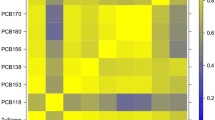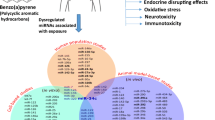Abstract
A number of environmental toxicants affect our health through physical, biological or chemical mechanisms. There is growing evidence indicating that microRNA (miRNA) plays an important role in toxicogenomics, disease aetiology and the effect of toxicants. This article summarises recent findings on miRNAs associated with various toxicants and those targeted in the development of therapeutics. Environmental epigenetic studies have revealed the role of miRNAs in the regulation of gene activities induced by environmental changes after exposure to toxic substances. Toxicant-induced changes in miRNA expression have a potential to be informative markers in the evaluation of toxicant risks. miRNAs are now considered to be predictive biomarkers or indicators of tissue injury due to toxicant exposure; thus, miRNAs can also be utilised as therapeutic targets.

Similar content being viewed by others
References
Amacher DE, Schomaker SJ, Aubrecht J (2013) Development of blood biomarkers for drug-induced liver injury: an evaluation of their potential for risk assessment and diagnostics. Mol Diagn Ther 17:343–354
Ammal Kaidery N, Tarannum S, Thomas B (2014) Epigenetic landscape of Parkinson’s disease: emerging role in disease mechanisms and therapeutic modalities. Neurotherapeutics 10:698–708
An J, Cai T, Che H, Yu T, Cao Z, Liu X, Zhao F, Jing J, Shen X, Liu M, Du K, Chen J, Luo W (2014) The changes of miRNA expression in rat hippocampus following chronic lead exposure. Toxicol Lett 229:158–166
Bai W, Chen Y, Yang J, Niu P, Tian L, Gao A (2014) Aberrant miRNA profiles associated with chronic benzene poisoning. Exp Mol Pathol 96:426–430
Banerjee A, Luettich K (2012) MicroRNAs as potential biomarkers of smoking-related diseases. Biomark Med 6:671–684
Bannon DI, Dillman JF, Hable MA, Phillips CS, Perkins EJ (2009) Global gene expression in rat brain and liver after oral exposure to the explosive hexahydro-1,3,5-trinitro-1,3,5-triazine (RDX). Chem Res Toxicol 22:620–625
Bolleyn J, De Kock J, Rodrigues RM, Vinken M, Rogiers V, Vanhaecke T (2014) MicroRNAs as key regulators of xenobiotic biotransformation and drug response. Arch Toxicol. doi:10.1007/s00204-014-1314-7
Chen CL, Liu H, Guan X (2013) Changes in microRNA expression profile in hippocampus during the acquisition and extinction of cocaine-induced conditioned place preference in rats. J Biomed Sci 20:96
Cho WC (2010) MicroRNAs in cancer—from research to therapy. Biochim Biophys Acta 1805:209–217
Darcq E, Warnault V, Phamluong K, Besserer GM, Liu F, Ron D (2014) MicroRNA-30a-5p in the prefrontal cortex controls the transition from moderate to excessive alcohol consumption. Mol Psychiatry. doi:10.1038/mp.2014.120
Datson GP (2008) Gene expression, dose-response, and phenotypic anchoring: applications for toxicogenomics in risk assessment. Toxicol Sci 105:233–234
Diniz GP, Takano AP, Barreto-Chaves ML (2013) miRNA-208a and miRNA-208b are triggered in thyroid hormone-induced cardiac hypertrophy—role of type 1 Angiotensin II receptor (AT1R) on miRNA-208a/α-MHC modulation. Mol Cell Endocrinol 374:117–124
Doxakis E (2010) Post-transcriptional regulation of α-synuclein expression by miR-7 and miR-153. J Biol Chem 285:12726–12734
Eom HJ, Chatterjee N, Lee J, Choi J (2014) Integrated mRNA and micro RNA profiling reveals epigenetic mechanism of differential sensitivity of Jurkat T cells to AgNPs and Ag ions. Toxicol Lett 229:311–318
Fernández AF, Toraño EG, Urdinguio RG, Lana AG, Fernández IA, Fraga MF (2014) The epigenetic basis of adaptation and responses to environmental change: perspective on human reproduction. Adv Exp Med Biol 753:97–117
Fry RC, Rager JE, Bauer R, Sebastian E, Peden DB, Jaspers I, Alexis NE (2014) Air toxics and epigenetic effects: ozone altered microRNAs in the sputum of human subjects. Am J Physiol Lung Cell Mol Physiol 306:L1129–L1137
Ge F, He QY (2009) Genomic and proteomic approacheds for predicting toxicity and adverse drug reactions. Expert Opin Drug Metab Toxicol 5:29–37
Gooderham NJ, Koufaris C (2014) Using microRNA profiles to predict and evaluate hepatic carcinogenic potential. Toxicol Lett 228:127–132
Goodrich JM, Dolinoy DC (2015) Environmental exposures: impact on the epigenome. In: Chadwick BP (ed) Epigenetics: current research and emerging trends. Caister Academic Press, USA
Guengerich FP (2006) Cytochrome P450s and other enzymes in drug metabolism and toxicity. AAPS J 8:E101–E111
Hébert SS, Horré K, Nicolaï L, Papadopoulou AS, Mandemakers W, Silahtaroglu AN, Kauppinen S, Delacourte A, De Strooper B (2008) Loss of microRNA cluster miR-29a/b-1 in sporadic Alzheimer’s disease correlates with increased BACE1/β-secretase expression. Proc Natl Acad Sci USA 105:6415–6420
Hébert SS, Horré K, Nicolaï L, Bergmans B, Papadopoulou AS, Delacourte A, De Strooper B (2009) MicroRNA regulation of Alzheimer’s amyloid precursor protein expression. Neurobiol Dis 33:422–428
Jardim MJ (2011) MicroRNAs: implications for air pollution research. Mutat Res 717:38–45
John-Baptiste A, Huang W, Kindt E, Wu A, Vitsky A, Scott W, Gross C, Yang AH, Schaiff WT, Ramaiah SK (2012) Evaluation of potential gastrointestinal biomarkers in a PAK4 inhibitor-treated preclinical toxicity model to address unmonitorable gastrointestinal toxicity. Toxicol Pathol 40:482–490
Joo MS, Lee CG, Koo JH, Kim SG (2013) miR-125b transcriptionally increased by Nrf2 inhibits AhR repressor, which protects kidney from cisplatin-induced injury. Cell Death Dis 4:e899
Junn E, Lee KW, Jeong BS, Chan TW, Im JY, Mouradian MM (2009) Repression of α-synuclein expression and toxicity by miR-7. Proc Natl Acad Sci USA 106:13052–13057
Koegl M, Tolle R, Deuschle U (2011) Drug research. In: Wink M (ed) An introduction to molecular biotechnology. Wiley-Blackwell, USA
Koturbash I, Beland FA, Poqribny IP (2012) Role of microRNAs in the regulation of drug metabolizing and transporting genes and the response to environmental toxicants. Expert Opin Drug Metab Toxicol 8:597–606
Lee CG, Kim JG, Kim HJ, Kwon HK, Cho IJ, Choi DW, Lee WH, Kim WD, Hwang SJ, Choi S, Kim SG (2014) Discovery of an integrative network of microRNAs and transcriptomics changes for acute kidney injury. Kidney Int 86:943–953
Lizarraga D, Gaj S, Brauers KJ, Timmermans L, Kleinjans JC, van Delft JH (2012) Benzo[a]pyrene-induced changes in microRNA-mRNA networks. Chem Res Toxicol 25:838–849
Marrone AK, Beland FA, Poqribny IP (2014) Noncoding RNA response to xenobiotic exposure: an indicator of toxicity and carcinogenicity. Expert Opin Drug Metab Toxicol 10:1409–1422
Mert M (2012) RNA interference. In: Tucker JB (ed) Innovation, dual use, and security. MIT Press, USA
Miranda RC (2014) MicroRNAs and ethanol toxicity. Int Rev Neurobiol 115:245–284
Molina-Pinelo S, Pastor MD, Suarez R, Romero-Romero B, González De la Peña M, Salinas A, García-Carbonero R, De Miguel MJ, Rodríguez-Panadero F, Carnero A, Paz-Ares L (2014) MicroRNA clusters: dysregulation in lung adenocarcinoma and COPD. Eur Respir J 43:1740–1749
Mouradian MM (2012) MicroRNAs in Parkinson’s disease. Neurobiol Dis 46:279–284
Nagano T, Higashisaka K, Kunieda A, Iwahara Y, Tanaka K, Nagano K, Abe Y, Kamada H, Tsunoda S, Nabeshi H, Yoshikawa T, Yoshioka Y, Tsutsumi Y (2013) Liver-specific microRNAs as biomarkers of nanomaterial-induced liver damage. Nanotechnology 24:405102
Nakajima M (2012) Role of microRNAs in the regulation of cytochrome P450s and transcriptional factors. Yakuqaku Zasshi 132:107–116
Nakajima M, Yokoi T (2011) MicroRNAs from biology to future pharmacotherapy: regulation of cytochrome P450s and nuclear receptors. Pharmacol Ther 131:330–337
Nerini-Molteni S, Mennecozzi M, Fabbri M, Sacco MG, Vojnits K, Compagnoni A, Gribaldo L, Bremer-Hoffmann S (2012) MicroRNA profiling as a tool for pathway analysis in a human in vitro model for neural development. Curr Med Chem 19:6214–6223
Nye MD, Fry RC, Hoyo C, Murphy SK (2014) Investigating epigenetic effects of prenatal exposure to toxic metals in newborns: challenges and benefits. Med Epigenet 2:53–59
Ogata K, Sumida K, Miyata K, Kushida M, Kuwamura M, Yamate J (2014) Circulating miR-9* and miR-384-5p as potential indicators for trimethyltin-induced neurotoxicity. Toxicol Pathol. doi:10.1177/0192623314530533
Oliveira-Carvalho V, Carvalho VO, Bocchi EA (2013) The emerging role of miR-208a in the heart. DNA Cell Biol 32:8–12
Pallocca G, Fabbri M, Sacco MG, Gribaldo L, Pamies D, Laurenza I, Bal-Price A (2013) miRNA expression profiling in a human stem cell-based model as a tool for developmental neurotoxicity testing. Cell Biol Toxicol 29:239–257
Peng Q, Huang W, John-Baptiste A (2014) Circulating microRNAs as biomarkers of retinal toxicity. J Appl Toxicol 34:695–702
Poma ML, Di Giorgio L (2008) Toxicogenomics to improve comprehension of the mechanisms underlying responses of in vitro and in vivo systems to nanomaterials: a review. Curr Genomics 9:571–585
Qiu C, Chen G, Ciu Q (2012) Towards the understanding of microRNA and environmental factor interactions and their relationships to human diseases. Sci Rep 2:318
Rager JE, Moeller BC, Miller SK, Kracko D, Doyle-Eisele M, Swenberg JA, Fry RC (2014) Formaldehyde-associated changes in microRNAs: tissue and temporal specificity in the rat nose, white blood cells, and bone marrow. Toxicol Sci 138:36–46
Ray PD, Yosim A, Fry RC (2014) Incorporating epigenetic data into the risk assessment process for the toxic metals arsenic, cadmium, chromium, lead, and mercury: strategies and challenges. Front Genet 5:201
Sadler-Riggleman I, Skinner MK (2015) Environment and the epigenetic transgenerational inheritance of disease. In: Chadwick BP (ed) Epigenetics: current research and emerging trends. Caister Academic Press, USA
Schonrock N, Ke YD, Humphreys D, Staufenbiel M, Ittner LM, Preiss T, Götz J (2010) Neuronal miRNA deregulation in response to Alzheimer’s disease amyloid-beta. PLoS ONE 5:e11070
Schuler J (2011) Industrial application: biotech industry, markets, and opportunities. In: Wink M (ed) An introduction to molecular biotechnology. Wiley-Blackwell, USA
Sharma S, Munshi A (2012) Pharmacogenomics in development of disease-specific therapeutic strategy. In: Barh D (ed) OMICS: biomedical perspectives and applications. Taylor & Francis Group, USA
Shi Q, Yang X, Mendrick DL (2013) Hopes and challenges in using miRNAs as translational biomarkers for drug-induced liver injury. Biomark Med 7:307–315
Shivdasani PA (2009) MicroRNAs: regulators of gene expression and cell differentiation. Blood 108:3646–3653
Siddeek B, Inoubli L, Lakhdari N, Rachel PB, Fussell KC, Schneider S, Mauduit C, Benahmed M (2014) MicroRNAs as potential biomarkers in diseases and toxicology. Mutat Res, Genet Toxicol Environ Mutagen 764–765:46–57
Smirnova L, Block K, Sittka A, Oelgeschläger M, Seiler AE, Luch A (2014) MicroRNA profiling as tool for in vitro developmental neurotoxicity testing: the case of sodium valproate. PLoS ONE 9:e98892
Starkey Lewis PJ, Merz M, Couttet P, Grenet O, Dear J, Antoine DJ, Goldring C, Park BK, Moggs JG (2012) Serum microRNA biomarkers for drug-induced liver injury. Clin Pharmacol Ther 92:291–293
Su YW, Chen X, Jiang ZZ, Wang T, Wang C, Zhang Y, Wen J, Xue M, Zhu D, Zhang Y, Su YJ, Xing TY, Zhang CY, Zhang LY (2012) A panel of serum microRNAs as specific biomarkers for diagnosis of compound- and herb-induced liver injury in rats. PLoS ONE 7:e37395
Thomas B, Beal MF (2007) Parkinson’s disease. Hum Mol Genet 16:R183–R194
Vliegenthart AD, Starkey Lewis P, Tucker CS, Del Pozo J, Rider S, Antoine DJ, Dubost V, Westphal M, Moulin P, Bailey MA, Moggs JG, Goldring CE, Park BK, Dear JW (2014) Retro-orbital blood acquisition facilitates circulating microRNA measurement in zebrafish with paracetamol hepatotoxicity. Zebrafish 11:219–226
Wang J, Cui QH (2012) Specific roles of microRNAs in their interactions with environmental factors. J Nucleic Acids 2012:978384
Wang B, Li Y, Shao C, Tan Y, Cai L (2012) Cadmium and its epigenetic effects. Curr Med Chem 19(16):2611–2620
Wang J, Yu JT, Tan MS, Jiang T, Tan L (2013) Epigenetic mechanisms in Alzheimer’s disease: implications for pathogenesis and therapy. Ageing Res Rev 12:1024–1041
Wang M, Huang Y, Liang Z, Liu D, Lu Y, Dai Y, Feng G, Wang C (2014) Plasma miRNAs might be promising biomarkers of chronic obstructive pulmonary disease. Clin Respir J. doi:10.1111/crj.12194
Wiemer EAC (2006) miRNAs and cancer. J RNAi Gene Silencing 2:173–174
Yokoi T, Nakajima M (2013) MicroRNAs as mediators of drug toxicity. Annu Rev Pharmacol Toxicol 53:377–400
Zarbl H (2007) Toxicogenomics analyses of genetic susceptibility to mammary gland carcinogenesis in rodents: implications for human breast cancer. Breast Dis 28:87–105
Zhang B, Pan X (2009) RDX induces aberrant expression of microRNAs in mouse brain and liver. Environ Health Perspect 117:231–240
Author information
Authors and Affiliations
Corresponding author
Rights and permissions
About this article
Cite this article
Yu, H.W., Cho, W.C. The role of microRNAs in toxicology. Arch Toxicol 89, 319–325 (2015). https://doi.org/10.1007/s00204-014-1440-2
Received:
Accepted:
Published:
Issue Date:
DOI: https://doi.org/10.1007/s00204-014-1440-2




